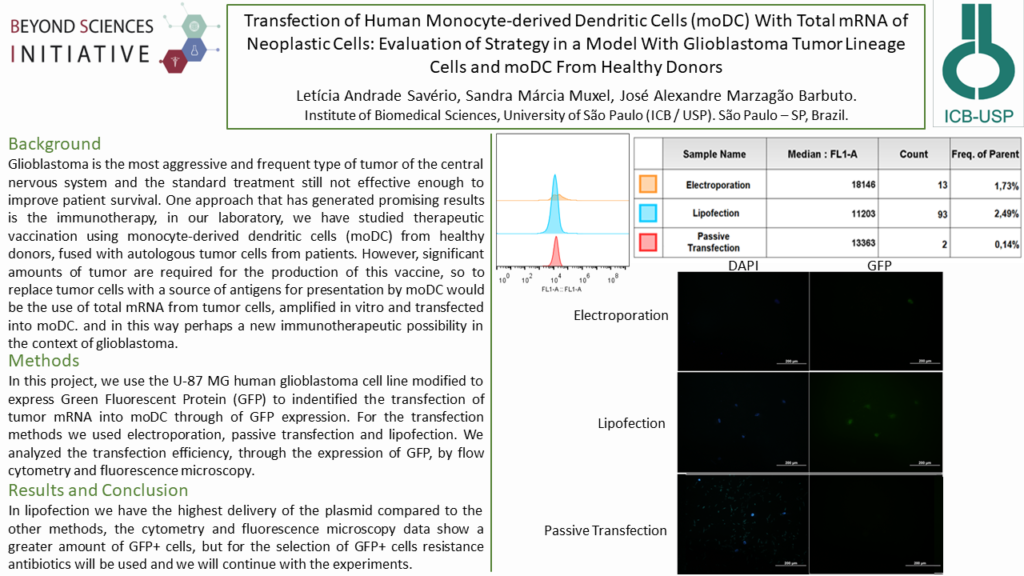Letícia A Savério
Conference 2023 Presentation
Project title
Transfection of human monocyte-derived dendritic cells (moDC) with total mRNA of Glioblastoma cell line
Authors and Affiliations
Letícia Savério1, Sandra Muxel1, José Barbuto1l
1. School of Population and Public Health, University of British Columbia, Vancouver, Canada 2. Faculty of Health Sciences, University of Ottawa, Ottawa, Canada
Abstract
Background
Glioblastoma is the most aggressive and frequent type of tumor of the central nervous
system and the standard treatment for this disease is still not effective enough to
improve patient survival. One approach that has generated promising results is the
immunotherapy of this neoplasm and, in our laboratory, we have studied therapeutic
vaccination using monocyte-derived dendritic cells (moDC) from healthy donors, fused
with autologous tumor cells from patients. However, significant amounts of tumor are
required for the production of this vaccine. One strategy to replace tumor cells with a
source of antigens for presentation by moDC would be the use of total mRNA from
tumor cells, amplified in vitro and transfected into moDC. Thus, in this project, we intend
to evaluate the methods of amplification of mRNA from tumor cells, transfection into
moDCs and the capacity and pattern of antigenic presentation of these transfected
moDCs.
Methods
For that, we transfected GFP plasmid (Agilent, #240051), through three methods: passive transfection, lipofection and electroporation. For the selection of cells that have the plasmid inserted, we use the antibiotic hygromycin B, which the plasmid is resistant to, to know which dose should be used, we performed the MTT cytotoxicity test, testing different concentrations
Results
With the cytotoxicity assay we observed 50% of cell viability with the use of 12ug/ml of hygromycin B. For the transfection analysis we used flow cytometry, which quantified GFP positive cells and used 7AAD as cell death marker. By electroporation we observed 752 7AAD positive cells and 13 GFP positive cells expressing a mean fluorescence intensity (MFI) of 18.146. In the lipofection group we observed 3,742 7AAD positive cells and 93 GFP positive cells with an MFI of 11,203. While in passive transfection 1,444 7AAD positive cells and 2 GFP positive cells were observed expressing the MFI of 13,363.
Conclusions
With these findings, we saw that the concentration of 12ug/ml of hygromycin B is not enough to efficiently select GFP positive cells, so it is necessary to increase the dose. About the result of the transfection efficiency, we observed that in the electroporation the smallest amount of cells in the well, because most of the cells die during the electric pulse, however the cells that resist and have the plasmid incorporated, express GFP strongly. While in the lipofection group we have the highest amount of dead cells, because the combination of lipofectamine and the use of hygromycin B, but we see a increasing the number of GFP positive cells. By passive transfection the delivery of the plasmid occurs freely by a process of passive diffusion through the cell membrane, without the use of a vector, therefore the number of GFP positive cells is very low and because it is less aggressive the number of dead cells is caused by the use of the antibiotic

